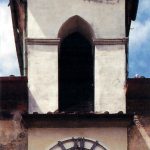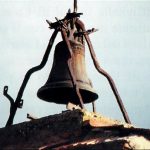With the Florentine reconstruction of the early 14th century, in front of the Church of Saints Ippolito and Cassiano stands the town hall building, dominated by a tall tower. The southern side, towards the valley, is enclosed by the building housing the parish priest’s residence and the walls descending towards the “postierla” of the Pieve. This main road (a kind of reinterpretation of the decumanus of Roman cities) is flanked by two parallel longitudinal streets (one on each side: the Spedale district to the south — now Via Trento — and the San Giuseppe district to the north), intersected orthogonally by smaller streets or alleyways (vicoli) that divide the rectangular-shaped building plots.
In the blocks between Borgo Maestro and Via di San Giuseppe, there is a long, parallel alleyway, serving as a secondary access and positioned in an intermediate location. Its layout is typologically similar to those found in the “terre nove” (new lands) of Florence. However, it is not as regular in design as these latter, which were derived from the French “Bastides” introduced by Frederick II.
The seat of the Community was initially located in the building with the clock tower, overlooking the current Piazza della Repubblica (a clock has been documented here since at least the late 17th century). The building was possibly renovated in 1795. The interventions in the historic center were of modest scope. During the course of the century, much of the town’s walls were lost, as they had already been partially demolished or reduced to ruins in 1809, becoming overgrown with caper plants.
In the second half of the 19th century, the town hall had already been moved to Via dello Spedale, while the Clock Tower building was repurposed for private residences. In 1923, the sculptor Piero Guerri designed a monument to the fallen, which was to be placed on the façade of the former town hall, beneath the clock. The renovated municipal building housed the town offices and schools. The main square was partially demolished, and it opened up with a balcony overlooking the valley of the Arno, offering a superb panoramic view towards the hills of Ponticino and Pergine.





